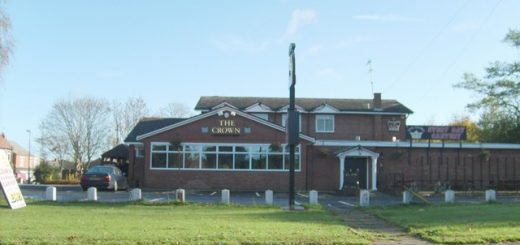Gef, The Talking Mongoose
It was in September 1931 that the Irving family of Doarlish Cashen, on the Isle of Man, came to prominence by reputedly being ‘haunted’ by a talking mongoose. Gef, as the animal preferred to be called, attracted wide media interest – even being investigated by Harry Price and Nandor Fodor. But what was Gef? Was he the result of a poltergeist focussing on the Irving’s twelve year old daughter, fraud perpetrated by the family, or was he simply a unique mongoose?
![Charles J Sharp [CC BY-SA 4.0 (https://creativecommons.org/licenses/by-sa/4.0)]](http://www.mysteriousbritain.co.uk/wp/wp-content/uploads/2008/07/800px-Banded_mongoose_Mungos_mungo_head-300x200.jpg) The case demonstrates many classic signs of poltergeist manifestation; Gef’s arrival was heralded by knocks, progressing to animal-like noises. By October both father, James and Voirrey had glimpsed “a small rat like body with a long bushy tail..” [1] By December, the entity started making sounds like a child trying to talk. Shortly after words came from behind the farmhouse walls were heard by the occupants. At the end of that month, the activity had progressed and a number of objects were thrown from a shelf [2]. Indeed Irving later mentioned that object throwing was a regular occurrence.
The case demonstrates many classic signs of poltergeist manifestation; Gef’s arrival was heralded by knocks, progressing to animal-like noises. By October both father, James and Voirrey had glimpsed “a small rat like body with a long bushy tail..” [1] By December, the entity started making sounds like a child trying to talk. Shortly after words came from behind the farmhouse walls were heard by the occupants. At the end of that month, the activity had progressed and a number of objects were thrown from a shelf [2]. Indeed Irving later mentioned that object throwing was a regular occurrence.
From the beginning Gef spent a lot of time around Viorrey, following, hunting, guarding, and even allowing himself to be photographed by her. For a poltergeist case physical manifestation is rare, though bearing in mind that most if not all of the sightings of Gef were seen by the family, usually Voirrey. Gef was almost never seen by outsiders. Eventually, as Fodor noted Gef seemed to tire of Voirrey, finding more “opportunity for learning in James…” [3] though he rarely mentions seeing Gef.
Gef’s origins may be closer to home. Almost twenty years previously some mongooses were released by a local farmer to help control the rat population. Indeed Gef made a number of rabbit kills. Possibly the mongooses may have survived, though there is an absence of similar talking mongoose report on the island or further afield. Other alleged talking animals tend to pronounce occasional words, and not the full sentences and idle gossip reportedly spouted by Gef.
Then there is the possibility of fraud. Visits by Price and Fodor to the farm proved unsuccessful and neither were witness to any significant activity. The majority of those who met the family, including to an extent Price and Fodor, were convinced of how genuine the family appeared. They were not seeking publicity or financial gain from the case, with press coverage received upsetting Irving [4], though as with all poltergeist cases, the victims/participants are open to accusations of fraud. Even the photographic evidence snapped by Voirrey showed very little. Only one picture purportedly showed Gef, though it could easily have been a cat sitting on a gatepost. Price had hair and teeth impressions (obtained from Gef by Voirrey) analysed, concluding that neither came from a mongoose. The hair came from a dog (coincidentally the Irving’s had a dog!) and the teeth impression analysis was inconclusive. Could Gef have been playing tricks on Price or was it Voirrey?
What happened to Gef? Perhaps the case was concluded sometime after the Irving’s had left the area. Fodor wrote that the new owner claimed to have shot a “weird looking animal” [5], which, he claimed was Gef. Certainly Gef appears to have disappeared around 1938/39. Walter McGraw writing for FATE Magazine claims to have spoken to Voirrey around 1970 [6], where she described the disappearance of Gef, he “… seemed to go away for longer and longer periods of time, and then he just never showed up again” [7]. Gef lasted 8 or 9 years, longer than typical poltergeist manifestations and like the phenomena, he seems to have faded away.
So what was Gef? Despite the case being well documented and the family not conclusively discredited, it is almost impossible to satisfactorily conclude what Gef was. It’s highly likely that Gef was a psychological creation of the family, a sort of invisible friend, created by Voirrey then adopted by the rest of the family. As Voirrey entered puberty she and Gef lost interest in each other and ‘ownership’ of Gef transferred to James. Their behaviour is indicative that Gef was probably a hallucination experienced by the remote family, and strengthened with the interest shown from outside. Many of the visitors trying to see Gef were convinced of the Irving’s sincerity, and reports indicate that they were respected in the community.
It could be that Gef was a psychological creation, more specifically a tulpa, a physical manifestation of a thought. A tulpa stems from Tibetan belief that thoughts can be manifested in the physical world. The phenomenon is best documented by Alexandre-David Neel, who spent a considerable amount of time in Tibet. Neel meditated on the creation of a monk. Eventually the manifestation became a physical being which would follow her around, though after a while its personality started to become distinctly sinister [8]. Gef also went through such a period, threatening to harm Voirrey in her sleep. So worried were the Irving’s that they moved her into their bedroom for several months.
One thing is certain, that in today’s modern hi-tech world, where everyone is just a click away from each other and there are few remaining truly remote areas, we’re unlikely to hear the scratching and mutterings of another talking mongoose.
[1] The Isle of Man Examiner, 19 Feb 1932
[2] ibid
[3] Fodor Nandor: Between Two Worlds
[4] The Isle of Man Examiner, 19 Feb 1932
[5] Fodor Nandor: Between Two Worlds P. 189
[6] William McGraw: Gef the Talking Mongoose in Name (Place, date) Pages
[7] ibid: P. 81
[8] Consider the website alexandra-david-neel.org for more on the explorer
Author Andrew Tibbs




Re: Gef, The Talking Mongoose
There seems to be quite a comeback in interest on this case lately, so I’ll add a few things.
First thing: sometimes Gef left rabbits for the family in the kitchen. R.S. Lambert, an associate of Harry Price’s, saw these rabbits and said they were killed by wriggling their necks, the same way as it’s traditionally done in farms around the world. There were no signs of bites.
Second thing: James Irving obtained some foot casts by asking Gef to walk over some plasticine blocks during the night. Irving dispatched these blocks to Harry price, who turned them over to the Zoological Department of the British Museum for identification. One print belonged to a dog and the others, curiously, were identified as belonging to "an American raccoon". Mongoose tracks their surely weren’t.
Third thing: before settling at Cashen’s Gap, James Irving had travelled all over the world. He was fluent in German and Russian and also knew quite a bit of Hindi. Gef claimed he was born "on June 7, 1852" in India and to have lived "with a tall man who wore a green turban on his head". When he was asked to elaborate on these two points, Gef usually laughed and sang Hindu folk songs.
Fourth thing: when Harry Price asked a local associate, a Captain Macdonald, to investigate the case, Gef seemed to be in top shape. He talked (calling Macdonald "a doubter" and instructing the Irving’s to "get him out of here") and threw small objects to the Captain. But when Harry Price went to Cashen’s Gap himself, the talkative mongoose remained quiet.
Fifth: Gef demanded to be fed. He usually asked for pastries and bananas, highly unusual food for a mongoose, talking or not.
Sixth: a mongoose was shot at Cashen’s Gap in 1947. This proves either the animals released in 1914 managed to survive and breed or that other mongooses were introduced at a later date.